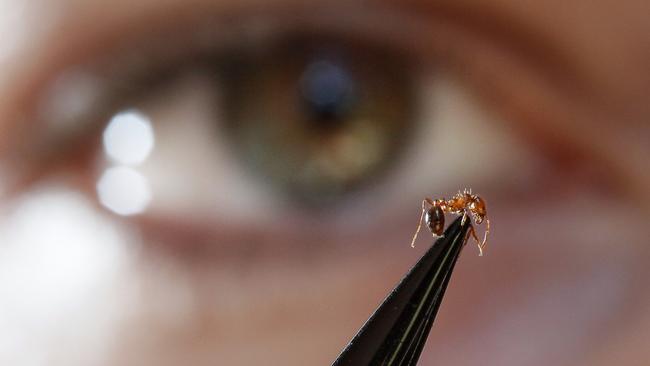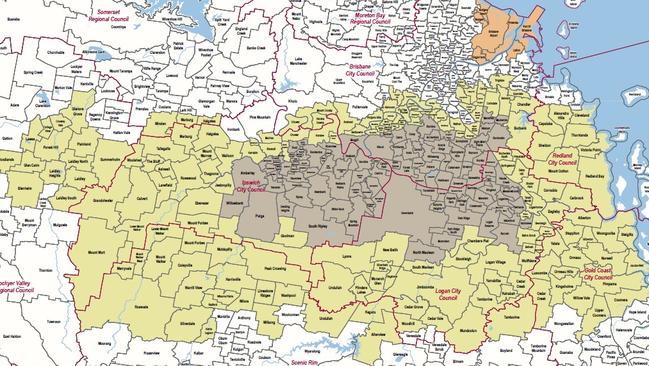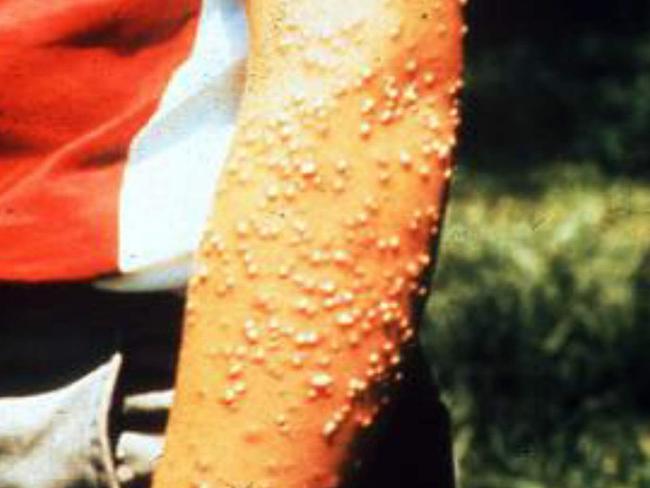Time running out to contain fire ant infestation
THONGS, barbecues and trips to the park could be a thing of the past if urgent action isn’t taken to stop this invasion of ants.

THONGS, barbecue and trips to the park could be a thing of the past if urgent action isn’t taken to put a lid on the spread of Australia’s most destructive invasive insect, experts have warned.
After 15 years and $330 million spent on eradication efforts, authorities have been unable to stop the spread of the fire ant, a vicious and aggressive pest which has wreaked havoc on large areas of the US, China and Taiwan.
“If they establish permanently in Queensland they will ruin our way of life, and have serious health and environmental impacts,” the Queensland Department of Agriculture and Fisheries warns. “Everyday activities, such as barbecues, picnics and sporting events may no longer be possible in high infestation areas.”
Highly aggressive, fire ants swarm their victims and bite en masse. Their stings can lead to anaphylaxis, a severe allergic reaction. In the US alone, 85 people have died from fire ant bites.
Originally from South America, fire ants first spread to the US in the 1930s and are now entrenched across most of the southern states of the country, which spends $7 billion a year on medical treatment, damage and control in affected areas.
Fire ants were first detected in Brisbane in 2001, and in September that year the National Fire Ant Eradication Program was formed in partnership with state governments.


At the time, the Australian Bureau of Agricultural and Resource Economics predicted a cost to Australia of $8.9 billion over 30 years if the ant was not controlled. According to the most recent analysis, the total impact to southeast Australia alone will top $45 billion over the next 30 years.
While some areas, such as the Port of Brisbane — one of the two initial detection sites — and Yarwun in Central Queensland, have successfully eradicated the pest, authorities are losing the overall war.
In 2014, the first fire ant nest was detected in NSW at Port Botany, sparking a massive response from the NSW Department of Primary Industries, which warned of billions of dollars of potential damage to the state economy.
Earlier this month, an independent review of the eradication program found time was running out and there was “only a small window of opportunity left” to eradicate the pest.
The report, obtained by the ABC, estimated that if the ants were not contained, the infestation would affect at least 20 sectors of the economy. It recommended ramping up funding for the eradication program to $380 million over the next 10 years, finding that every dollar spent on eradication would save $25 later on.
Daniel Spring from the University of Melbourne, who conducted analysis for the review, said although the invasion has spread, “fire ant numbers have effectively been suppressed and some individual infestations have been eradicated”.

“These facts, and the availability of a cheaper monitoring method involving remote sensing with airborne cameras, have kept alive eradication hopes,” he wrote in The Conversation.
But while agriculture ministers still believe an eradication is technically possible, “geographic expansion of the invasion cannot continue much longer without the invasion becoming too large to eradicate”, he wrote.
“The choice is to continue eradication efforts or live with fire ants forever. Living with fire ants will incur large costs for agricultural producers and households.
“Large numbers of people are likely to come into contact with fire ants if the species is left unchecked. Environmental damages could also be substantial. These losses far exceed estimated eradication costs.
“The review panel’s report makes it clear that we face an urgent choice between increased eradication funding or living with fire ants. There is not much time left to make this choice.”
Invasive Species Council chief executive Andrew Cox said earlier this month that while it was too late for the US to eradicate fire ants, Australia still has a chance.
“Fire ants will be a massive hit to our economy, our environment, our healthcare system and our outdoor lifestyle if we do not act now,” he said.
“Until now Australia’s fire ant eradication program has been compromised by underfunding, repeated reviews and lack of certainty. We cannot afford to be idle — federal, state and territory governments must immediately commit to fully fund a 10-year eradication program.”

Ipswich Mayor Paul Pisasale is at the epicentre of the fire ant infestation. He says unless the problem is dealt with soon, the entire Australian way of life will be in jeopardy.
“Thongs and barbecues will be a thing of the past, our kids won’t be able to go to the park,” he told news.com.au. “If we lose those, our Australian identity will be down the drain.
“I just don’t know how these little fire ants have outsmarted the Australian government. Look at how they’ve destroyed countries all over the world.
“The most important thing we have in this country and in my city is 400 beautiful parks. Last year we had to close one of the parks. We’ve had to train 22 staff. A couple of kids have been bitten.
“I get so many emails and I’m having so many meetings about this. These are not just normal ants, they’re aggressive little creatures.”
State agriculture ministers will meet next year to determine whether to ramp up the eradication program or move to a management plan.
Mr Pisasale says that’s not good enough. “The states are getting together next year to talk about what they’re going to do,” he said.
“I know what you need to do — get rid of the little buggers. I’m sick and tired of all the meetings. This is not about Liberal or Labor. Stop talking about start putting a plan in place to get rid of these things.
“All these other states think they’re safe — they’re not safe. They’ll spread everywhere. I don’t want to scare them, but the longer they leave it, the more expensive it’s going to become. Take this matter of fire ants seriously. The Australian way of life depends on it.”
But Geoff Kent, director of the Biosecurity Queensland Control Centre, said the National Fire Ant Eradication program had been “successful at keeping the level of infestation very low and to a relatively small area in southeast Queensland”.
“Of the 411,500 hectares within the fire ant biosecurity zones in southeast Queensland, it is estimated that there is only around one per cent of actual fire ant infestation,” he said.
“Given how quickly fire ants are known to spread, an uncontrolled fire ant population in southeast Queensland would be in the order of 160 times worse — about 69 million hectares impacted — than the infestation we currently have.
“If left uncontrolled, the impacts in Australia have been estimated to be between $5.3 billion and $45 billion over 20 to 70 years. The program has effectively prevented these impacts from being realised in Australia.”




